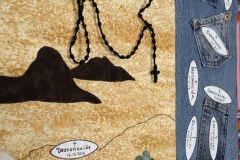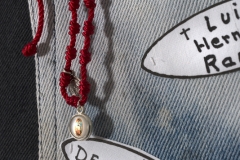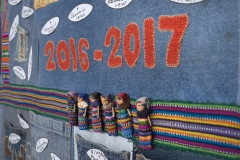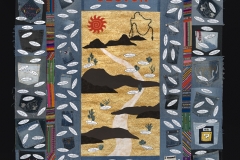Quiltmakers’ statements:
Our group decided to focus on pockets for our theme since they held things important to migrants (and we primarily had denim found in the desert to work with). We each ripped seams of the jeans to separate the large and coin pockets, then cut squares from the jean legs and machine-stitched the pockets back on. The Guatemalan striped fabric was from a found piece and represents the many migrants traveling from Central America; we cut it to make a frame around the denim. The center piece was hand appliquéd from donated fabric to illustrate the desert and the mountains, while the cactus and hot red sun represent the grueling journey north.
We were almost finished with the quilt when we learned about a dead hummingbird found in the pocket of a migrant. We learned that colibri, Spanish for “hummingbird,” is a symbol of safe passage, a messenger between the living and the dead and decided to add a hummingbird, hand painted by a member of our group. We purposely left the quilt’s edges frayed, as most found fabric is dirty and worn.
As one who searches the desert and mountains for lost migrants, I appreciated the use of pockets. Touching each pocket brought questions about what hopes and fears were carried there on that one’s desperate journey for a future of safety and self-determination – for a future of freedom from want and violence.
Barbara Lemmon
I first saw several of the migrant quilts when they were laid out on tables for documenting. As we recorded information about them, I felt a bit uneasy. They represented so much tragedy and death. Later our church had an exhibit of them. I began to see the sorrow and caring that went into making them. Gradually I realized that these quilts were works of love. It was a moving experience making this with others as we shared ideas and worked to honor each person, many whose names will never be known.
Judy Breneman
I am a quilter. I’ve created many quilts but working on the Migrant Quilt has been more than a creative effort for me. It has been a spiritually rewarding experience. The act of writing and then sewing onto the quilt the names of the migrants who died in the desert, seeking a safer and better life for themselves and their families, was both moving and humbling.
Susan Kirk
After displaying 12 Migrant Quilts at our church in Spring 2017, we knew we wanted to make one also. When we received the 145 names, I was overwhelmed by the fact that only 22 names were known – the rest were Desconocidos. Mostly denim is found these days, so we used all we could. Denim is strong fabric; it lasts even in the desert, and reminds us of the strength and hope of these migrants.
Deanna Brooks
Seeing the quilts at our church last year touched my heart. When I approached the coordinator, she graciously agreed for our Unitarian Universalist Church to take the 145 names and discarded clothing to make a wall hanging to honor the few known and the many unknown who died in our desert. We chose the jeans fabric and pockets, all found in our Sector. It’s been an honor to be involved in this deeply meaningful project.
Judy Harmer
Desiring and having peace and well-being should be a human right. The courage to find such a place crossing a harsh environment as a desert is remarkable. It is an honor to acknowledge in the simple way of making a quilt the lives lost in their aborted journey to freedom and to recognize their vanished steps as a memorial.
Betty-Lee Hepworth




